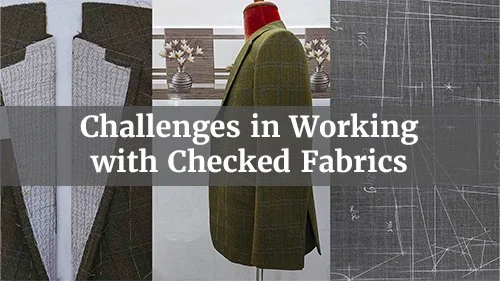Craftsmanship Beneath the Surface
The Art of Pad Stitching in Bespoke Tailoring
In the world of bespoke tailoring, there are many techniques that set a custom-made garment apart from mass-produced clothing. One of these specialized methods is pad stitching — an essential hand-stitching technique that brings structure, shape, and character to tailored pieces. Although it often goes unnoticed once the garment is complete, pad stitching plays a critical role in the fit and feel of a well-made suit, jacket, or coat.
What Is Pad Stitching?
Pad stitching of haircloth/ canvas for a jacket.
Pad stitching is a hand-sewing technique used to attach layers of fabric, particularly the canvas interfacing, to the outer cloth of a jacket or coat. Typically found in the lapels, collar, and chest of a tailored garment, this intricate process involves a series of small, diagonal stitches that secure the canvas while allowing the garment to maintain flexibility. This technique ensures that the fabric molds beautifully to the shape of the body, resulting in a smooth roll of the lapel and a natural contour that machine-sewing simply cannot replicate.
The Role of Pad Stitching in Tailoring
The purpose of pad stitching is more than just attaching layers together. It gives structure and form to the garment, helping to achieve the desired shape that a bespoke suit needs. In the lapel, for instance, pad stitching provides the lapel with its roll—a crucial part of the silhouette in a tailored jacket. A skilled tailor carefully manipulates the fabric and canvas to ensure the roll is smooth and that the lapel sits correctly, with a look that is both elegant and relaxed.
Craftsmanship and Technique
Pad stitching is done entirely by hand, and the quality of the work depends on the skill of the tailor. Each stitch must be made with precision, balancing strength with flexibility. The spacing and tension of the stitches can vary depending on the location and purpose—closer stitches are used where more stiffness is required, while looser stitches allow for a softer drape.
The canvas used for pad stitching is traditionally made from horsehair and wool, chosen for its resilience and ability to shape over time. The canvas acts as the skeleton of the jacket, and through pad stitching, the tailor breathes life into the garment, giving it a three-dimensional structure that enhances the body’s natural lines.
A Hidden Masterpiece
What makes pad stitching truly special is that it is hidden beneath the fabric, invisible to the wearer but crucial to the overall quality of the garment. It’s one of those hidden details that embodies the essence of bespoke tailoring—an investment in craftsmanship that goes beyond what meets the eye. For clients, knowing that pad stitching has been used in the construction of their garment provides a sense of quality and tradition that fast-fashion alternatives simply cannot match.
Pad stitching is an art form that reflects the dedication and expertise of bespoke tailoring. It’s one of the many techniques that make a tailored suit fit and feel exceptional, offering a level of structure and comfort that only handcrafted garments can provide. Next time you see a beautifully rolled lapel or feel the structure of a perfectly tailored jacket, remember the hours of craftsmanship behind those seemingly invisible stitches.
For more insights into the craft of bespoke tailoring, explore our blog and learn what makes each garment truly unique.









